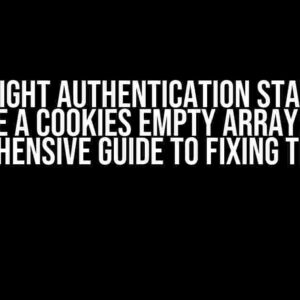Are you tired of dealing with the limitations of traditional deep linking methods? Do you want to provide a seamless user experience for your app’s users? Look no further! In this article, we’ll dive into the world of Universal Links and explore how to harness their power with ASWebAuthenticationSession, specifically when `prefersEphemeralWebBrowserSession` is set to `false`. Buckle up and get ready to take your app’s linking capabilities to the next level!
The Magic of Universal Links
Universal Links, introduced in iOS 9, allow developers to create links that open in their app instead of Safari. This game-changing feature enables a native app experience, eliminating the need for users to switch back and forth between apps and browsers. But how do we make it work?
ASWebAuthenticationSession: The Key to Unlocking Universal Links
Enter ASWebAuthenticationSession, a class that provides a way to authenticate users and redirect them to your app. By leveraging this powerful tool, you can create a seamless experience for your users. But what happens when we set `prefersEphemeralWebBrowserSession` to `false`?
The Role of prefersEphemeralWebBrowserSession
In a nutshell, `prefersEphemeralWebBrowserSession` determines whether the authentication session should happen in a temporary, ephemeral browser session or in the main Safari browser. When set to `true`, the authentication session will occur in a temporary session, whereas setting it to `false` will use the main Safari browser. But what does this mean for our Universal Links?
Implementing Universal Links with ASWebAuthenticationSession and prefersEphemeralWebBrowserSession = false
Now that we’ve set the stage, let’s dive into the implementation. Follow these step-by-step instructions to unlock the power of Universal Links with ASWebAuthenticationSession and `prefersEphemeralWebBrowserSession` set to `false`:
Step 1: Configure Your App’s Associated Domains
In your Xcode project, navigate to your target’s Capabilities tab and ensure that Associated Domains is enabled. Add your domain (e.g., `applinks:example.com`) to the list of associated domains.
<key>com.apple.developer.associated-domains</key>
<array>
<string>applinks:example.com</string>
</array>Step 2: Create an AASA File
Create a JSON file named `apple-app-site-association` (AASA) and upload it to your domain. This file contains the configuration for your Universal Links.
{
"applinks": {
"apps": [],
"details": [
{
"appID": "YOUR_TEAM_ID.com.example.app",
"paths": ["/universal-link"]
}
]
}
}Step 3: Handle Universal Links in Your App
In your app delegate, add the following code to handle Universal Links:
- (BOOL)application:(UIApplication *)application continueUserActivity:(NSUserActivity *)userActivity restorationHandler:(void (^)(NSArray *))restorationHandler {
if ([userActivity.activityType isEqualToString:NSUserActivityTypeBrowsingWeb]) {
NSURL *url = userActivity.webpageURL;
// Handle the Universal Link
[self handleUniversalLink:url];
return YES;
}
return NO;
}Step 4: Authenticate with ASWebAuthenticationSession
Now, let’s create an instance of ASWebAuthenticationSession and set `prefersEphemeralWebBrowserSession` to `false`:
- (void)handleUniversalLink:(NSURL *)url {
ASWebAuthenticationSession *session = [[ASWebAuthenticationSession alloc] initWithURL:url callbackURLScheme:@"example" completionHandler:^(NSURL * _Nullable callbackURL, NSError * _Nullable error) {
if (error) {
NSLog(@"Error: %@", error);
return;
}
// Handle the authentication result
[self handleAuthenticationResult:callbackURL];
}];
session.prefersEphemeralWebBrowserSession = NO;
[session start];
}Step 5: Handle the Authentication Result
Finally, handle the authentication result in your app:
- (void)handleAuthenticationResult:(NSURL *)callbackURL {
NSLog(@"Authentication result: %@", callbackURL);
// Update your app's state accordingly
}Troubleshooting and Best Practices
As with any new feature, you might encounter some hiccups along the way. Here are some troubleshooting tips and best practices to keep in mind:
Troubleshooting Tips
- Verify that your AASA file is correctly formatted and uploaded to your domain.
- Ensure that your app’s Associated Domains are configured correctly in Xcode.
- Check that your app is correctly handling the Universal Link in the app delegate.
- Verify that `prefersEphemeralWebBrowserSession` is set to `false` in your ASWebAuthenticationSession instance.
Best Practices
- Use a unique callback URL scheme for your app to avoid conflicts with other apps.
- Handle errors and edge cases gracefully to provide a seamless user experience.
- Test your Universal Links thoroughly to ensure they work as expected.
- Consider using a third-party library to simplify the implementation process.
Conclusion
And that’s a wrap! With these step-by-step instructions and troubleshooting tips, you’re now equipped to unlock the power of Universal Links with ASWebAuthenticationSession and `prefersEphemeralWebBrowserSession` set to `false`. By following these guidelines, you’ll be able to provide a seamless, native app experience for your users. Happy coding!
| Keyword | Description |
|---|---|
| Universal Links | A feature that allows developers to create links that open in their app instead of Safari. |
| ASWebAuthenticationSession | A class that provides a way to authenticate users and redirect them to your app. |
| prefersEphemeralWebBrowserSession | A property that determines whether the authentication session should happen in a temporary, ephemeral browser session or in the main Safari browser. |
By mastering Universal Links with ASWebAuthenticationSession and `prefersEphemeralWebBrowserSession` set to `false`, you’ll be able to take your app’s linking capabilities to new heights. Remember to test thoroughly, handle errors gracefully, and provide a seamless user experience for your users.
- ASWebAuthenticationSession Documentation
- Supporting Universal Links in Your App
- prefersEphemeralWebBrowserSession Property
Frequently Asked Question
Get ready to uncover the secrets of Universal Links with ASWebAuthenticationSession where prefersEphemeralWebBrowserSession is set to false!
What is the main advantage of using Universal Links with ASWebAuthenticationSession?
The main advantage is that it provides a seamless user experience, allowing users to open your app directly from a universal link, without the need to open Safari or another browser!
What happens when prefersEphemeralWebBrowserSession is set to false?
When prefersEphemeralWebBrowserSession is set to false, the authentication session will reuse an existing browser session if one exists, instead of creating a new ephemeral session, which can improve performance and reduce memory usage!
How does ASWebAuthenticationSession handle universal links when prefersEphemeralWebBrowserSession is set to false?
When a universal link is opened, ASWebAuthenticationSession will prompt the user to authenticate, and if successful, will redirect the user to your app, reusing an existing browser session if one exists, for a more seamless experience!
What are the benefits of reusing an existing browser session?
Reusing an existing browser session can reduce memory usage, improve performance, and provide a more seamless user experience, as users won’t have to re-authenticate or re-enter their credentials!
Are there any limitations or considerations when using Universal Links with ASWebAuthenticationSession and prefersEphemeralWebBrowserSession set to false?
Yes, you should be aware of the requirements for Universal Links, ensure that your app is properly configured, and test your implementation thoroughly to ensure a smooth user experience!






